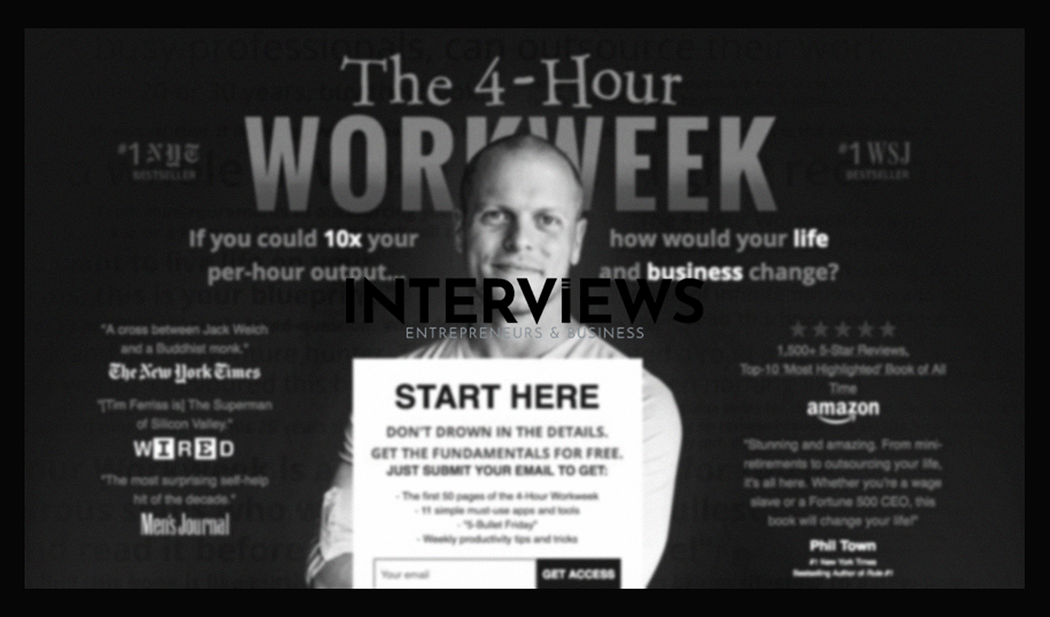Decoding the 4-Hour Work Week: More Than Just a Myth
The term “4-Hour Work Week” feels like a dream. It attracts the overworked. Yet, beneath the title, lies a philosophy on productivity. It is not solely about four hours of work and endless relaxation. It’s a fundamental change in your work-life approach that values efficiency.
D.E.A.L.: Your Escape Route from the 9-to-5 Grind
Tim Ferriss, the master behind the 4-Hour Work Week, presents D.E.A.L. This framework is an escape from mundane work life. D.E.A.L. means Definition, Elimination, Automation, and Liberation. These four pillars create a life where work enhances your living experience, not consume it.
Question Everything: The Rebel’s Guide to Work
The essence of the 4-Hour Work Week challenges common ideas. It urges you to challenge every belief about work. Why toil until retirement? Why link busyness with success? Ferriss demonstrates that crafting a fulfilling life starts by questioning outdated norms.
Meet the New Rich: Time is the New Currency
Forget old definitions of wealth tied to possessions gained over years. The “New Rich” (NR) reshape wealth. They value time and freedom over cash and titles. To them, luxury is the ability to choose their day and experiences. They prove that life can be adventurous now, not just after retirement.
Selective Ignorance: The Art of Tuning Out the Noise
In our connected world, information overload kills productivity. Ferriss recommends a “low-information diet.” Think of your brain as a computer. Constant interruptions slow everything down. Selective ignorance helps you consume only what matters to keep your mental focus sharp.
The 80/20 Rule: Work Smarter, Not Just Harder
Pareto’s Principle, or the 80/20 rule, is your productivity ally. It’s straightforward: 80% of results arise from 20% of efforts. Focus on that small critical 20% driving most impact. This isn’t just a theory; it’s a tool to maximize your time and resources effectively.
Outsource Like a Pro: Don’t Do Everything Yourself
Want free time? Outsource tasks. Seriously, leverage outsourcing as if your life depends on it. Why waste hours on tasks others can accomplish faster? Whether virtual assistants or freelancers, let them handle tasks while you focus on your expertise.
Automation: Let the Machines Do the Heavy Lifting
Automation is not something far off; it’s here to save you. Identify repetitive tasks as time-sinks. Eliminate them using automation tools. Software and apps can manage tasks like automated emails, scheduling, or AI assistance, all working for you even when you aren’t.
Time Management: It’s About Focus, Not Just Hours
Forget working harder. The focus is on working smarter. Time management involves maximizing your productive hours instead of filling days with busywork. Prioritize focused actions on significant tasks for better outcomes.
Dreamlining: Designing Your Ideal Life, Step by Step
Dreamlining involves more than wishful thinking; it plans your ideal life strategically. Tim Ferriss coined it as a process for defining dreams with actionable steps and timelines. It focuses on dreaming big while making those dreams realistic and attainable.
Fear Setting: Facing Your Fears, Freeing Your Future
Fear can paralyze decisions. Fear of failure or unfamiliarity holds you back. Fear setting allows you to confront these fears. Analyze what might actually occur. Reality often isn’t as daunting as perceived fears. Attacking fears diminishes their power and enables courageous choices.
Implementing the 4-Hour Work Week: From Theory to Reality
Enough with theory. Let’s get actionable. How to implement the 4-Hour Work Week approach? Focus on these vital strategies:
Prioritize Ruthlessly: 80/20 in Action
Remember the 80/20 rule? Use it now. Identify the top 20% of tasks delivering significant results and concentrate on those. Everything else is a distraction. Keep your focus laser-sharp on impactful activities and say “no” to unimportant ones.
Automate and Delegate: Your Productivity Dream Team
Automation works best with delegation. Automate each repetitive task possible; think email filters, scheduling software, automated posts. Delegate tasks outside your expertise to virtual assistants or freelancers. This frees you up for essential work.
Quality Over Quantity: Making Every Hour Count
The 4-Hour Work Rule promotes quality. When working, focus intensely on high-quality output in those four hours instead of just clocking in long hours of trivial activities. Aim to work deeply rather than simply long.
Time Blocking: Schedule Your Success
Time blocking is crucial for focused productivity. Segment your day into time blocks dedicated to specific activities. Schedule everything from emails to creative tasks and breaks. Treat these as unmissable appointments for maximum engagement.
Communicate Clearly: Setting Expectations
To embrace the 4-Hour Work Week, communication is vital. Inform your team and clients about your new schedule and its impacts. Being upfront with expectations ensures smooth transitions with no misunderstandings.
Embrace Flexibility: Adapt and Evolve
The 4-Hour Work Week embodies flexibility, not rigid rules. Adjust schedules and approaches according to needs. Experimentation allows discovering what fits best for you. Flexibility helps achieve long-term outcomes despite life’s surprises.
The 4-Day Work Week: A Close Cousin, Not the Same
I want to clarify the term 4-Day Work Week. While it relates to the 4-Hour Work Week philosophy of reduced hours, they are different concepts. The 4-Day Work Week compresses a traditional 40-hour week into fewer days.
Structure Variations: Choose Your Flavor of 4-Day Week
No single structure fits all for the 4-day week. Here are common options:
- Reduced Hours: Also called “100-80-100,” this method gains popularity. Employees work four 8-hour days (32 hours total) while receiving full pay and maintaining productivity levels.
- Compressed Hours: You still clock in 40 hours but within four longer days (like four 10-hour days). Enjoy a three-day weekend with more intense workdays.
- Maintaining 40 Hours, Fewer Days: Similar to compressed hours, this structure squeezes 40 hours into four days with longer shifts.
Implementing a 4-Day Week: Practical Steps
Want to shift towards a 4-day week? Here’s how:
- Flex Fridays or No Meeting Wednesdays:
- Start slowly. Introduce “Flex Fridays” for more autonomy and “No Meeting Wednesdays” for focused efforts. These are helpful first steps.
- Flexible, Responsible Culture: A 4-day week needs trust and autonomy. Your workplace must value results alongside flexibility.
- Ample Time for Transition: Avoid rushing. Plan the transition well to allow changes and ensure success.
The Benefits of a 4-Day Work Week: Companies Moving Forward
The 4-day week offers real benefits:
- Improved Work-Life Balance: This perk stands out. An extra day off allows employees to enjoy personal interests, be with family, and recharge.
- Boost in Productivity and Satisfaction: Studies reveal great outcomes. Microsoft Japan noted a 40% rise in productivity during a trial of the 4-day week. Happy, rested employees work better.
- Better Retention and Talent Attraction: A 4-day week attracts talent in a competitive job market. It retains valuable employees and brings in new ones.
The Downsides of a 4-Day Work Week: Possible Issues
However, it isn’t perfect. Watch for possible downsides:
- Stress from Work Compression: Fitting five days of work into four days can create intensity. Employees may feel pressured to speed up.
- Scheduling Issues and Reduced Coverage: Coordinating schedules can become challenging with fewer workdays. Customer service may suffer.
- Impact on Customer Satisfaction: Reduced availability can lead to customer dissatisfaction if mishandled.
- Not for All Industries: A 4-day week is not one-size-fits-all. Some industries or roles, particularly those needing constant coverage, may not fit.
Tim Ferriss’s Financial Strategies: More Than Just the 4-Hour Week
Tim Ferriss embodies lifestyle design. His financial journey illustrates the principles he teaches:
- Entrepreneurial Start: Ferriss began with BrainQUICKEN while working a regular job. Side hustles are key.
- Book Publication Success:The 4-Hour Workweek became a bestseller, leading Ferriss to financial freedom. Books can be great assets.
- Investment Savvy: Ferriss is an angel investor, supporting companies like TaskRabbit and Reputation.com. Diverse income is vital.
- Podcast and Speaking Engagements:The Tim Ferriss Show generates revenue through ads and sponsorships. Content creation can yield profits.
Alternative Work Schedules: Beyond One Standard Model
The 4-Hour and 4-Day Work Week are just beginnings. Many alternative schedules exist:
- 9/80 Schedule: Work 80 hours in nine days (eight 9-hour days and one 8-hour day) for a long weekend every other week. This leads to compressed work weeks with extended weekends.
- 4-5-5-4 Shift Pattern: This rotates between 4-day and 5-day weeks, creating longer weekends. It offers a work-break rhythm.
- DuPont Schedule: A rotating 12-hour shift for 24/7 operations that focuses on productivity while considering employee wellness. It’s complex yet ensures continuous operations.
Reality Check: Considerations and Limitations
The “4-Hour Work Week” as a literal concept is elusive for most. It’s more an aspiration. It focuses on optimization rather than just four hours of work. Consider these points:
- Practicality: Don’t expect to turn into a four-hour worker overnight. It requires a journey of optimization.
- Pay Laws: Know local labor regulations. For instance, California has a 4-hour minimum pay rule, ensuring fair compensation.
- Productivity Bounds: Research indicates most people are effective for about 3-4 hours daily. The concept echoes this natural limit.
Bonus Rules: Food Safety, Emergency Jobs, and Waste Reduction
These might feel off-topic, but here are some “4-hour” rules:
- The 4-R Principle (Reduce, Reuse, Recycle, Recover): This is about environmental care, not work hours. It’s crucial but not directly linked to the 4-Hour Work Week.
- 90/10 Rule: This reverses the 80/20 rule, asserting 90% of effort comes in the last 10% of projects. Not strictly time management, more project-related.
- 4-Hour Emergency Department Goal: This healthcare standard aims for processing patients in four hours. Important for efficiency in health care, but not tied to the 4-Hour Work Week.
In conclusion, the 4-Hour Work Week is a mindset. It challenges traditional work norms. It’s about designing a life with freedom and efficiency. It’s about working smarter and reclaiming time for a fulfilling life. Who doesn’t want that?





